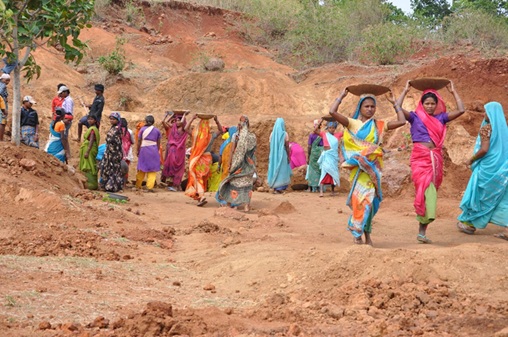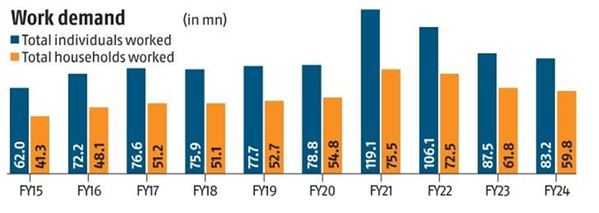Context
Recently, the Ministry of Rural Development (MoRD) amended Schedule I of the Mahatma Gandhi National Rural Employment Guarantee Act (MGNREGA), 2005.

Background
- MNREGA Act: Ensures that every state government provides at least 100 days of guaranteed employment to every rural household in a financial year.
- Schedule I: Defines the list of public works and the minimum features of the scheme.
- Amendment Process: Although amendments to the Act require Parliament's approval, the central government can implement these amendments through notifications. Since 2005, the Act has been amended approximately 24 times.
About the Latest Amendment
- New Provision: Now, a minimum expenditure ratio for water harvesting works has been mandated at the block level, which will be determined based on groundwater status.
- Previous Provision: Previously, 60% of works at the district level focused on creating productive resources related to agriculture and related activities through land, water, and tree development.
- Objective: To allocate a fixed minimum amount for water conservation and water harvesting works in rural India.
- Key Objective: To address India's growing groundwater crisis and promote sustainable rural livelihoods.
- Ratio of expenditure on water works:
- Minimum 65% of MNREGA funds for over-exploited blocks (groundwater extraction more than 100%)
- 65% for critical blocks (90-100%)
- 40% for semi-critical blocks (70-90%)
- 30% for safe blocks (≤70%)
- Classification reference: These classifications are based on the Dynamic Groundwater Resources Assessment Report 2024 of the Central Ground Water Board (CGWB).
- Out of a total of 6,746 blocks:
- Over-exploited: 751 (11.13%)
- Critical: 206 (3.05%)
- Semi-critical: 711 (10.54%)
- Safe: 4,951 (73.39%)
- Saline: 127 blocks

Potential Benefits of the Amendment
-
Of the ₹86,000 crore allocated for MNREGA in FY 2025-26, approximately ₹35,000 crore is likely to be spent on water conservation works.
-
More funds for water conservation works will accrue to states with a higher number of over-exploited and critical blocks, such as Rajasthan (214), Punjab (115), Tamil Nadu (106), Haryana (88), and Uttar Pradesh (59).
Importance for Rural India
- It promotes climate-resilient rural infrastructure.
- Links MNREGA with the Jal Shakti Abhiyan and Atal Bhujal Yojana.
- Promotes community-based interventions to mitigate groundwater stress.
- Encourages employment generation in water management works.
Way Forward
- Integrated planning: Synergize with the Pradhan Mantri Krishi Sinchai Yojana (PMKSY) and watershed programs.
- Capacity building: Training gram sabhas and local engineers on scientific water management.
- Monitoring and transparency: Use of GIS mapping and real-time dashboards for implementation tracking.
- Focus on sustainability: Promote recharge structures, afforestation, and soil-water conservation.
Conclusion
This amendment signals a strategic shift in India's rural employment and water management framework. By linking MNREGA works with water sustainability, the government is promoting rural livelihoods and climate resilience, while also addressing one of India's most pressing environmental challenges.
|
Mahatma Gandhi National Rural Employment Guarantee Act (MGNREGA)
Start
- The Act was passed on September 7, 2005, and came into effect on February 2, 2006.
- MNREGA has been implemented in 741 districts by October 12, 2025.
Objectives:
- To provide 100 days of guaranteed unskilled manual employment per financial year to rural households.
- To develop rural infrastructure and alleviate poverty.
Eligibility:
- Adults above 18 years of age in rural areas who are willing to do unskilled manual labor.
- No income limit; all rural households are eligible.
Types of Employment
- Water conservation, tree plantation, rural road construction, flood control, micro-irrigation projects.
- Workplace within 5 km of the applicant's residence.
Wages and Payments:
- State-determined minimum wage (average ₹230-₹350/day in 2025, depending on the state).
- Payment within 14 days to a bank/post office account, through DBT (Direct Benefit Transfer).
- Women to have at least 33% employment share.
Unemployment Allowance:
- If employment is not found within 15 days, 25% of the minimum wage (for the first 30 days) and 50% (thereafter) allowance.
- Borne by the state government.
Implementation:
- Managed by the Ministry of Rural Development, through Panchayati Raj Institutions.
- Job cards mandatory; monitoring of works through online registration and geo-tagging.
- Social audit and RTI implemented for transparency.
Impact and Achievements
- By 2023-24, over 300 million job cards have been issued, benefiting 70 million families.
- Increased rural incomes, reduced migration, and promoted social inclusion.
- More than 4.5 lakh water conservation projects completed.
|



